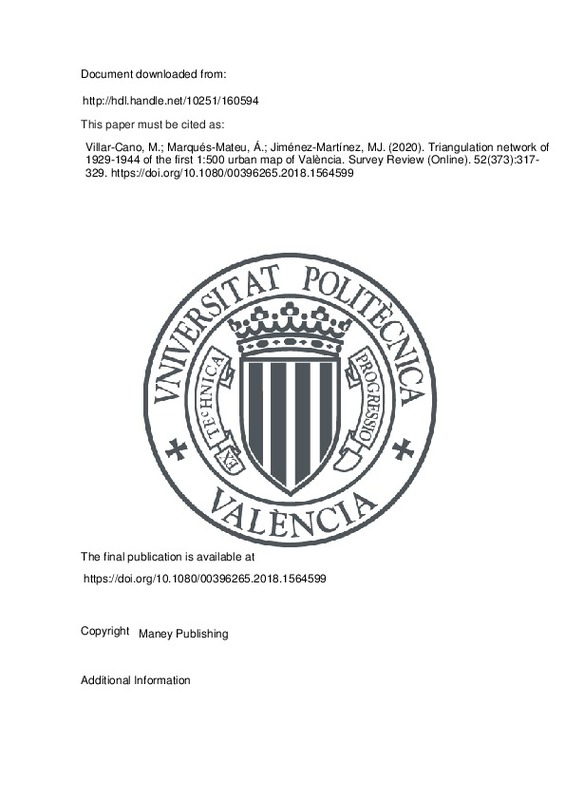JavaScript is disabled for your browser. Some features of this site may not work without it.
Buscar en RiuNet
Listar
Mi cuenta
Estadísticas
Ayuda RiuNet
Admin. UPV
Triangulation network of 1929-1944 of the first 1:500 urban map of València
Mostrar el registro sencillo del ítem
Ficheros en el ítem
| dc.contributor.author | VILLAR-CANO, MIRIAM
|
es_ES |
| dc.contributor.author | Marqués-Mateu, Ángel
|
es_ES |
| dc.contributor.author | Jiménez-Martínez, Mª Jesús
|
es_ES |
| dc.date.accessioned | 2021-02-03T04:33:26Z | |
| dc.date.available | 2021-02-03T04:33:26Z | |
| dc.date.issued | 2020-07-03 | es_ES |
| dc.identifier.uri | http://hdl.handle.net/10251/160594 | |
| dc.description.abstract | [EN] Triangulation is a surveying method on which earlier maps made were based. Although the origins of the method can be traced back to the 16th century, it is still used today, with minor changes, to adjust networks observed with modern geodetic techniques. In this paper we present the geodetic survey work that was carried out for the primary triangulation network of the first 1:500 urban map of the city of València (Spain). It spanned from 1929 to 1944 and resulted in 421 maps covering about 174 square kilometres. We focus on four key elements to define the geometric framework of a map: (1) the geodetic network, (2) the cartographic projection, (3) the baseline measurements, and (4) the primary triangulation. The paper is based on the interpretation of original documents and field books recovered from the archives of the València City Council. In order to check the accuracy and consistency of the survey work, we recomputed all calculations directly from the field data, following the mathematical procedures of the time. We obtained a set of transformation parameters to convert the coordinates of 1929 to current coordinates based on the European Terrestrial Reference System of 1989 (ETRS89). Results showed that the 1929 primary triangulation angles and coordinates are accurate to 8 s of arc and 35 cm respectively, and that the coordinates transform well into the current reference system with average residuals of 26 cm across nine control points, demonstrating the high quality of the 1929 work. | es_ES |
| dc.language | Inglés | es_ES |
| dc.publisher | Maney Publishing | es_ES |
| dc.relation.ispartof | Survey Review (Online) | es_ES |
| dc.rights | Reserva de todos los derechos | es_ES |
| dc.subject | Urban mapping | es_ES |
| dc.subject | Triangulation | es_ES |
| dc.subject | Cartographic heritage | es_ES |
| dc.subject | Quality control | es_ES |
| dc.subject | Geodetic surveying | es_ES |
| dc.subject | ETRS89 | es_ES |
| dc.subject.classification | INGENIERIA CARTOGRAFICA, GEODESIA Y FOTOGRAMETRIA | es_ES |
| dc.title | Triangulation network of 1929-1944 of the first 1:500 urban map of València | es_ES |
| dc.type | Artículo | es_ES |
| dc.identifier.doi | 10.1080/00396265.2018.1564599 | es_ES |
| dc.rights.accessRights | Abierto | es_ES |
| dc.contributor.affiliation | Universitat Politècnica de València. Departamento de Ingeniería Cartográfica Geodesia y Fotogrametría - Departament d'Enginyeria Cartogràfica, Geodèsia i Fotogrametria | es_ES |
| dc.contributor.affiliation | Universitat Politècnica de València. Escuela Técnica Superior de Ingeniería Geodésica, Cartográfica y Topográfica - Escola Tècnica Superior d'Enginyeria Geodèsica, Cartogràfica i Topogràfica | es_ES |
| dc.description.bibliographicCitation | Villar-Cano, M.; Marqués-Mateu, Á.; Jiménez-Martínez, MJ. (2020). Triangulation network of 1929-1944 of the first 1:500 urban map of València. Survey Review (Online). 52(373):317-329. https://doi.org/10.1080/00396265.2018.1564599 | es_ES |
| dc.description.accrualMethod | S | es_ES |
| dc.relation.publisherversion | https://doi.org/10.1080/00396265.2018.1564599 | es_ES |
| dc.description.upvformatpinicio | 317 | es_ES |
| dc.description.upvformatpfin | 329 | es_ES |
| dc.type.version | info:eu-repo/semantics/publishedVersion | es_ES |
| dc.description.volume | 52 | es_ES |
| dc.description.issue | 373 | es_ES |
| dc.identifier.eissn | 1752-2706 | es_ES |
| dc.relation.pasarela | S\383216 | es_ES |
| dc.description.references | Bitelli, G., Cremonini, S., & Gatta, G. (2014). Cartographic heritage: Toward unconventional methods for quantitative analysis of pre-geodetic maps. Journal of Cultural Heritage, 15(2), 183-195. doi:10.1016/j.culher.2013.04.003 | es_ES |
| dc.description.references | Blachut, T. J., Chrzanowski, A., & Saastamoinen, J. H. (1979). Urban Surveying and Mapping. doi:10.1007/978-1-4612-6145-2 | es_ES |
| dc.description.references | Brinker, R. C., & Minnick, R. (Eds.). (1987). The Surveying Handbook. doi:10.1007/978-1-4757-1188-2 | es_ES |
| dc.description.references | Gatta, G. 2010. Valorizzazione di cartografia storica attraverso moderne tecniche geomatiche: recupero metrico, elaborazione e consultazione in ambiente digitale [Valuation of historic cartography using modern geomatics techniques: metric recovering, making and use in digital environment]. Doctoral thesis. Bologna: Universitá di Bologna. 295 pages. (In Italian). | es_ES |
| dc.description.references | Gorse, C., Johnston, D., & Pritchard, M. (2012). A Dictionary of Construction, Surveying and Civil Engineering. doi:10.1093/acref/9780199534463.001.0001 | es_ES |
| dc.description.references | Hotine, M. (1939). THE RE-TRIANGULATION OF GREAT BRITAIN IV—BASE MEASUREMENT. Empire Survey Review, 5(34), 211-225. doi:10.1179/sre.1939.5.34.211 | es_ES |
| dc.description.references | Kahmen, H., & Faig, W. (1988). Surveying. doi:10.1515/9783110845716 | es_ES |
| dc.description.references | Leick, A., Rapoport, L., & Tatarnikov, D. (2015). GPS Satellite Surveying. doi:10.1002/9781119018612 | es_ES |
| dc.description.references | Murdin, P. (2009). Full Meridian of Glory. doi:10.1007/978-0-387-75534-2 | es_ES |
| dc.description.references | Schofield, W., & Breach, M. (2007). Engineering Surveying. doi:10.1201/b12847 | es_ES |
| dc.description.references | Seeber, G. (2003). Satellite Geodesy. doi:10.1515/9783110200089 | es_ES |
| dc.description.references | Snyder, J. P. (1987). Map projections: A working manual. Professional Paper. doi:10.3133/pp1395 | es_ES |







![[Cerrado]](/themes/UPV/images/candado.png)

